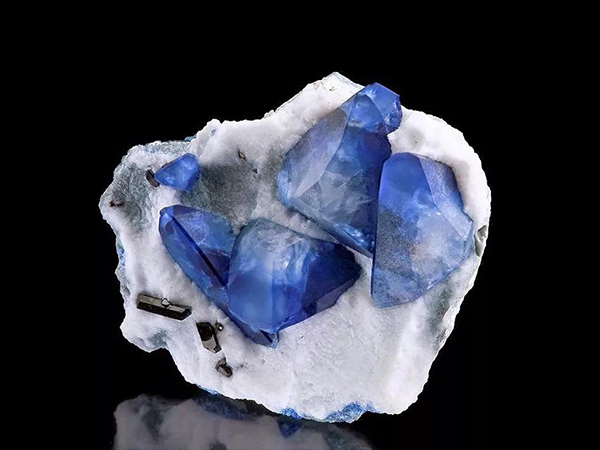BENITOITE

The blue cone ore, also known as silicon bismuth ore, is a rare blue silicate mineral containing bismuth and titanium, which is found in hydrothermally-replaced serpentinite. The blue cone mine has a bright blue to blue-white fluorescence reaction under short-wave ultraviolet rays, and the more rare the blue-cone crystals can clearly see red fluorescent light under long wavelengths.
Introduction
The blue cone mineral faceted gemstone has a distinct appearance, but the gemstone is generally small, and the clean and flawless faceted bare stone is rarely heavier than 1ct, and is often used for collection. It is mainly produced from serpentine rock with columnite and sodium zeolite. At present, the only gem-quality blue cone crystal in the world is produced in San Benito County, California, USA, and the output is very rare.
In 1907, American geologist George Lauderberg used the English name Benitoite for the first time to name minerals found in the San Benito River in San Benito County, California, USA. The English name was taken from the local place name.
Although blue cones have been discovered elsewhere, only mineral crystals of the highest quality and can be used as semi-precious stones have been produced in California so far, so in 1985, the blue cone mine became the state stone of California.
Structure and crystal form
There are many rings (Si3O9) composed of three silicon oxytetrahedrons in the crystal structure of the blue cone, and titanium oxide octahedron (TiO6) and tantalum polyhedron (BaO6) are connected between the ring and the ring.
In terms of crystal form, the blue cone ore belongs to the complex trigonal biconite family in the hexagonal system. Therefore, a triangular pyramidal crystal form appears on the crystal form. When the 32 point group is inferred in 1832, there are three crystal groups. There are no related examples, the crystal family is one of them. The twin crystal of the blue cone is extremely rare.
Basic nature
1. Chemical composition: barium titanate, BaTiSi3O9
2. Crystal system: hexagonal system
3. Crystal: mostly columnar and plate
4. Cleavage: a group of incomplete cleavage
5. Fracture: shell shape
6. Hardness: 6.5
7. Proportion: 3.68
8. Refractive index: 1.75-1.80
9. Birefringence: 0.047
10. Photometric: one-axis crystal phototropism
11. Gloss: bright glass luster
12. Dispersion: high, 0.046; similar to the dispersion of diamond. Fire color can be partially obscured by body color
13. Transparency: transparent to translucent
14. Color: blue to purple, colorless
15. Polychromaticity: strong; blue and colorless
16. Luminescence: Invented bright blue light under short-wave ultraviolet light. Colorless, dim red light under long-wave ultraviolet light.
Identification feature
1. Color: blue, blue-violet;
2. High RI and DR values, RI1.75-1.80DR0.047;
3. The color of the luminescent characteristic: especially the blue blue cone mineral invents bright blue fluorescence under short-wave ultraviolet light. Can be used as one of the diagnostic tests;
4. Polychromaticity: strong; blue and colorless, the color in both directions is very different;
5. Fire color: Due to the high dispersion value, "fire color" may appear in the 0.046 finished blue cone mine;
the difference
The color characteristic of the blue cone is similar to that of the sapphire, but it has strong pleochroism. Generally, the top facet is observed as blue, and the parallel waist is observed as colorless, which is obviously different from sapphire blue-green or green-blue. The blue cone has a large birefringence of 0.047, and it is positive light, and the facet of the facet under the microscope is obvious.
The blue cone mineral dispersion is very strong (0.046), although some of it is covered by body color, but the excellent cut blue cone mine shows a vivid appearance. In addition, the blue cone ore has bright blue fluorescence in short-wave ultraviolet light, while sapphire is inert or weakly fluorescent.
Place of origin
Blue cones are often symbiotic with some, unusual minerals that do not contain major rock-forming minerals in the parent rock. Common symbiotic ore is: sodium zeolite, column star stone, sodium silicate titanium, serpentine and albite.
The blue cone mines are produced in San Benito County and Arkansas, California, USA, Qinghai, Liguchuan City, Niigata Prefecture, Japan, and Odomomachi, Tokyo.
The blue cone mines produced in San Benito County are often found in the sodium zeolite veins in the blue amphibole schist; the blue cone mines produced in Japan are in the magnesia amphibole-quartz-phlogopite that runs through the serpentinite. In the veins of albite.
